YOLOv5-FF: Detecting Floating Objects on the Surface of Fresh Water Environments
Abstract
:1. Introduction
- (1)
- a channel attention mechanism is proposed to support the interaction of channels in different ways. It aims to supporting the interaction of channels over a long distance while preserving the direct correspondence between channels and their weights.
- (2)
- an adaptive feature extraction convolution module is proposed to focus on the feature information of objects in the process of feature extraction. It has been applied to the neck to alleviate the impact of the feature loss caused by downsampling operations.
- (3)
- a feature expression enhancement module is proposed to expand the received fields of feature maps without losing small objects. It has been applied to the neck to ensure that a feature map can cover the objects of different scales in a certain range.
- (4)
- a new detection layer is constructed by exploiting all the feature maps generated by the backbone. It is designed specially for detecting small even extra small objects.
2. Theoretical Basis
2.1. YOLOv5
2.2. Attention Mechanism
2.3. Dilated Encoder
2.4. K-Mediods Clustering Algorithm
3. Improved Floating Object Detection Solution
3.1. A hybrid Attention Mechanism Supporting Two Ways of Channel Interaction
3.2. Adaptive Feature Extraction Convolution Module
3.3. Feature Expression Enhancement Module
3.4. Special Detection Layer for Small Objects
3.5. Prior Box Generation with K-Mediods
4. Experiments
4.1. Experimental Setup
4.2. Dataset
4.3. Ablation Study
4.4. Performance Comparison
5. PFWD—An Intelligent Detecting System Based on YOLOv5-FF
6. Conclusions
Author Contributions
Funding
Institutional Review Board Statement
Informed Consent Statement
Data Availability Statement
Conflicts of Interest
References
- Jin, S.J.; Kwon, Y.J.; Yoo, S.H. Economic Valuation of Reducing Submerged Marine Debris in South Korea. Appl. Sci. 2020, 10, 6086. [Google Scholar] [CrossRef]
- Gall, S.C.; Thompson, R.C. The impact of debris on marine life. Mar. Pollut. Bull. 2015, 92, 170–179. [Google Scholar] [CrossRef]
- Lin, F.; Hou, T.; Jin, Q.; You, A. Improved YOLO Based Detection Algorithm for Floating Debris in Waterway. Entropy 2021, 23, 1111. [Google Scholar] [CrossRef]
- Biermann, L.; Clewley, D.; Martinez-Vicente, V.; Topouzelis, K. Finding Plastic Patches in Coastal Waters using Optical Satellite Data. Sci. Rep. 2020, 10, 5364. [Google Scholar] [CrossRef] [Green Version]
- Zhang, X.; Gao, Q.; Yan, J.; Ji, D.; Luo, Y. Water quality affected by floating debris near the dam section of Three Gorges Reservoir. Hupo Kexue/J. Lake Sci. 2020, 32, 609–618. [Google Scholar]
- Kumar, S.; Yadav, D.; Gupta, H.; Verma, O.P.; Ahn, C.W. A Novel YOLOv3 Algorithm-Based Deep Learning Approach for Waste Segregation: Towards Smart Waste Management. Electronics 2020, 10, 14. [Google Scholar] [CrossRef]
- Kylili, A. Identifying floating plastic marine debris using a deep learning approach. Environ. Sci. Pollut. Res. Int. 2019, 26, 17091–17099. [Google Scholar] [CrossRef] [PubMed]
- Garcia-Garin, O.; Borrell, A.; Aguilar, A.; Cardona, L.; Vighi, M. Floating marine macro-litter in the North Western Mediterranean Sea: Results from a combined monitoring approach. Mar. Pollut. Bull. 2020, 159, 111467. [Google Scholar] [CrossRef]
- Wolf, M.; Berg, K.V.D.; Garaba, S.P.; Gnann, N.; Zielinski, O. Machine learning for aquatic plastic litter detection, classification and quantification (APLASTIC-Q). Environ. Res. Lett. 2020, 15, 114042. [Google Scholar] [CrossRef]
- Yi, Z.; Yao, D.; Li, G.; Ai, J.; Xie, W. Detection and localization for lake floating objects based on CA-faster R-CNN. Multimed. Tools Appl. 2022, 81, 17263–17281. [Google Scholar] [CrossRef]
- Gupta, H.; Verma, O. Normalization free Siamese network for object tracking. Expert Syst. 2022, e13214. [Google Scholar] [CrossRef]
- Li, S.; Liu, S.; Cai, Z.; Liu, Y.; Chen, G.; Tu, G. TC-YOLOv5: Rapid detection of floating debris on raspberry Pi 4B. J. Real-Time Image Process. 2023, 20, 17. [Google Scholar] [CrossRef]
- Armitage, S.; Awty-Carroll, K.; Clewley, D.; Martinez-Vicente, V. Detection and Classification of Floating Plastic Litter 391 Using a Vessel-Mounted Video Camera and Deep Learning. Remote Sens. 2022, 14, 3425. [Google Scholar] [CrossRef]
- Yang, X.; Zhao, J.; Zhao, L.; Zhang, H.; Li, L.; Ji, Z.; Ganchev, I. Detection of River Floating Garbage Based on Improved YOLOv5. Mathematics 2022, 10, 4366. [Google Scholar] [CrossRef]
- Hou, Q.; Zhou, D.; Feng, J. Coordinate Attention for Efficient Mobile Network Design. arXiv 2021, arXiv:2103.02907. [Google Scholar]
- Tan, M.; Pang, R.; Le, Q.V. EfficientDet: Scalable and Efficient Object Detection. In Proceedings of the 2020 IEEE/CVF Conference on Computer Vision and Pattern Recognition (CVPR), Seattle, WA, USA, 13–19 June 2020. [Google Scholar]
- Lin, T.Y.; Dollar, P.; Girshick, R.; He, K.; Hariharan, B.; Belongie, S. Feature Pyramid Networks for Object Detection. IEEE Comput. Soc. 2017, abs/1612.03144, 2117–2125. [Google Scholar]
- Huang, J.; Jiang, X.; Jin, G. Detection of River Floating Debris in UAV Images Based on Improved YOLOv5. In Proceedings of the 2022 International Joint Conference on Neural Networks (IJCNN), Honolulu, HI, USA, 21–26 July 2017; IEEE: New York, NY, USA, 2022; pp. 1–8. [Google Scholar]
- Liu, Y.; He, G.; Wang, Z.; Li, W.; Huang, H. NRT-YOLO: Improved YOLOv5 based on nested residual transformer for tiny remote sensing object detection. Sensors 2022, 22, 4953. [Google Scholar] [CrossRef] [PubMed]
- Wan, F.; Sun, C.; He, H.; Lei, G.; Xu, L.; Xiao, T. YOLO-LRDD: A lightweight method for road damage detection based on improved YOLOv5s. EURASIP J. Adv. Signal Process. 2022, 2022, 98. [Google Scholar] [CrossRef]
- Ren, M.; Wan, W.; Yu, Z.; Zhao, Y. Bidirectional YOLO: Improved YOLO for foreign object debris detection on airport runways. J. Electron. Imaging 2022, 31, 063047. [Google Scholar] [CrossRef]
- Liu, H.; Sun, F.; Gu, J.; Deng, L. Sf-yolov5: A lightweight small object detection algorithm based on improved feature fusion mode. Sensors 2022, 22, 5817. [Google Scholar] [CrossRef]
- Yan, B.; Li, J.; Yang, Z.; Zhang, X.; Hao, X. AIE-YOLO: Auxiliary Information Enhanced YOLO for Small Object Detection. Sensors 2022, 22, 8221. [Google Scholar] [CrossRef] [PubMed]
- Jiang, X.; Hu, H.; Liu, X.; Ding, R.; Xu, Y.; Shi, J.; Du, Y.; Da, C. A smoking behavior detection method based on the YOLOv5 network. J. Phys. Conf. Ser. 2022, 2232, 012001. [Google Scholar] [CrossRef]
- Alkoffash, M.S. Automatic Arabic Text Clustering using K-means and K-mediods. Int. J. Comput. Appl. 2012, 51, 5–8. [Google Scholar]
- Ultralytics. YOLOV5-Master. 2021. Available online: https://github.com/ultralytics/yolov5.git/ (accessed on 22 December 2021).
- Wang, W.; Xie, E.; Song, X.; Zang, Y.; Wang, W.; Lu, T.; Yu, G.; Shen, C. Efficient and accurate arbitrary-shaped text detection with pixel aggregation network. In Proceedings of the IEEE/CVF International Conference on Computer Vision, Seoul, Republic of Korea, 27 October–2 November 2019; pp. 8440–8449. [Google Scholar]
- Woo, S.; Park, J.; Lee, J.Y.; Kweon, I.S. Cbam: Convolutional block attention module. In Proceedings of the European Conference on Computer Vision (ECCV), Munich, Germany, 8–14 September 2018; pp. 3–19. [Google Scholar]
- Chen, Q.; Wang, Y.; Yang, T.; Zhang, X.; Cheng, J.; Sun, J. You only look one-level feature. In Proceedings of the IEEE/CVF Conference on Computer Vision and Pattern Recognition, Nashville, TN, USA, 20–25 June 2021; pp. 13039–13048. [Google Scholar]
- Zhou, R.; Li, X.; Jiang, W. SCANet: A Spatial and Channel Attention based Network for Partial-to-Partial Point Cloud Registration. Pattern Recognit. Lett. 2021, 151, 120–126. [Google Scholar] [CrossRef]
- Ioffe, S.; Szegedy, C. Batch Normalization: Accelerating Deep Network Training by Reducing Internal Covariate Shift. In Proceedings of the ICML’15: 32nd International Conference on International Conference on Machine Learning, Lille, France, 6–11 July 2015; Volume 37, pp. 448–456. [Google Scholar]
- Ultralytics. GitHub–Ultralytics/Ultralytics: YOLOv8. 2021. Available online: https://github.com/ultralytics/ultralytics.git (accessed on 10 June 2023).
- Wang, C.Y.; Bochkovskiy, A.; Liao, H.Y.M. YOLOv7: Trainable bag-of-freebies sets new state-of-the-art for real-time object detectors. arXiv 2022, arXiv:2207.02696. [Google Scholar]
- Ge, Z.; Liu, S.; Wang, F.; Li, Z.; Sun, J. YOLOX: Exceeding YOLO Series in 2021. arXiv 2021, arXiv:2107.08430. [Google Scholar]
- Bochkovskiy, A.; Wang, C.Y.; Liao, H. YOLOv4: Optimal Speed and Accuracy of Object Detection. arXiv 2020, arXiv:2004.10934. [Google Scholar]
- Redmon, J.; Farhadi, A. YOLOv3: An Incremental Improvement. arXiv 2018, arXiv:1804.02767. [Google Scholar]
- Berg, A.C.; Fu, C.Y.; Szegedy, C.; Anguelov, D.; Erhan, D.; Reed, S.; Liu, W. SSD: Single Shot MultiBox Detector. arXiv 2015, arXiv:1512.02325. [Google Scholar]
- Ren, S.; He, K.; Girshick, R.; Sun, J. Faster R-CNN: Towards Real-Time Object Detection with Region Proposal Networks. IEEE Trans. Pattern Anal. Mach. Intell. 2017, 39, 1137–1149. [Google Scholar] [CrossRef] [PubMed] [Green Version]
- Qiao, G.; Yang, M.; Wang, H. A Detection Approach for Floating Debris Using Ground Images Based on Deep Learning. Remote Sens. 2022, 14, 4161. [Google Scholar] [CrossRef]

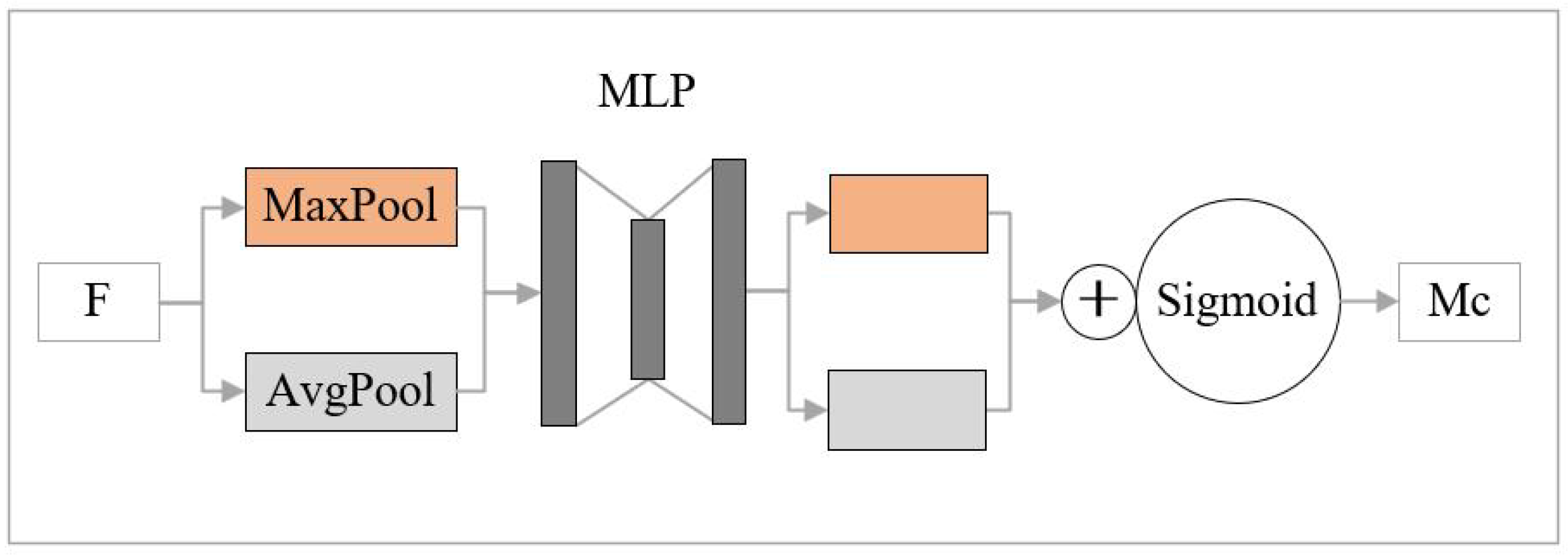
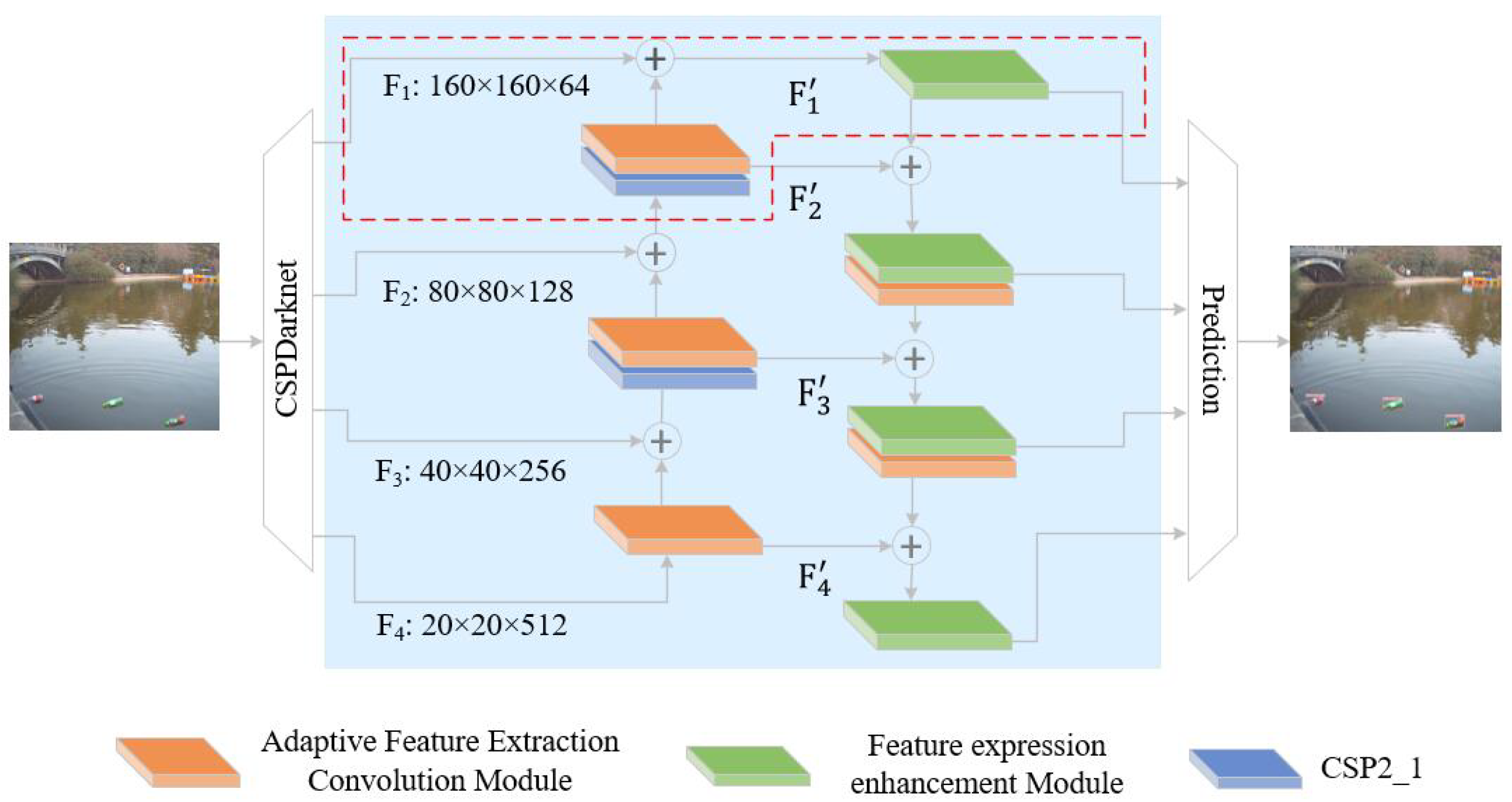
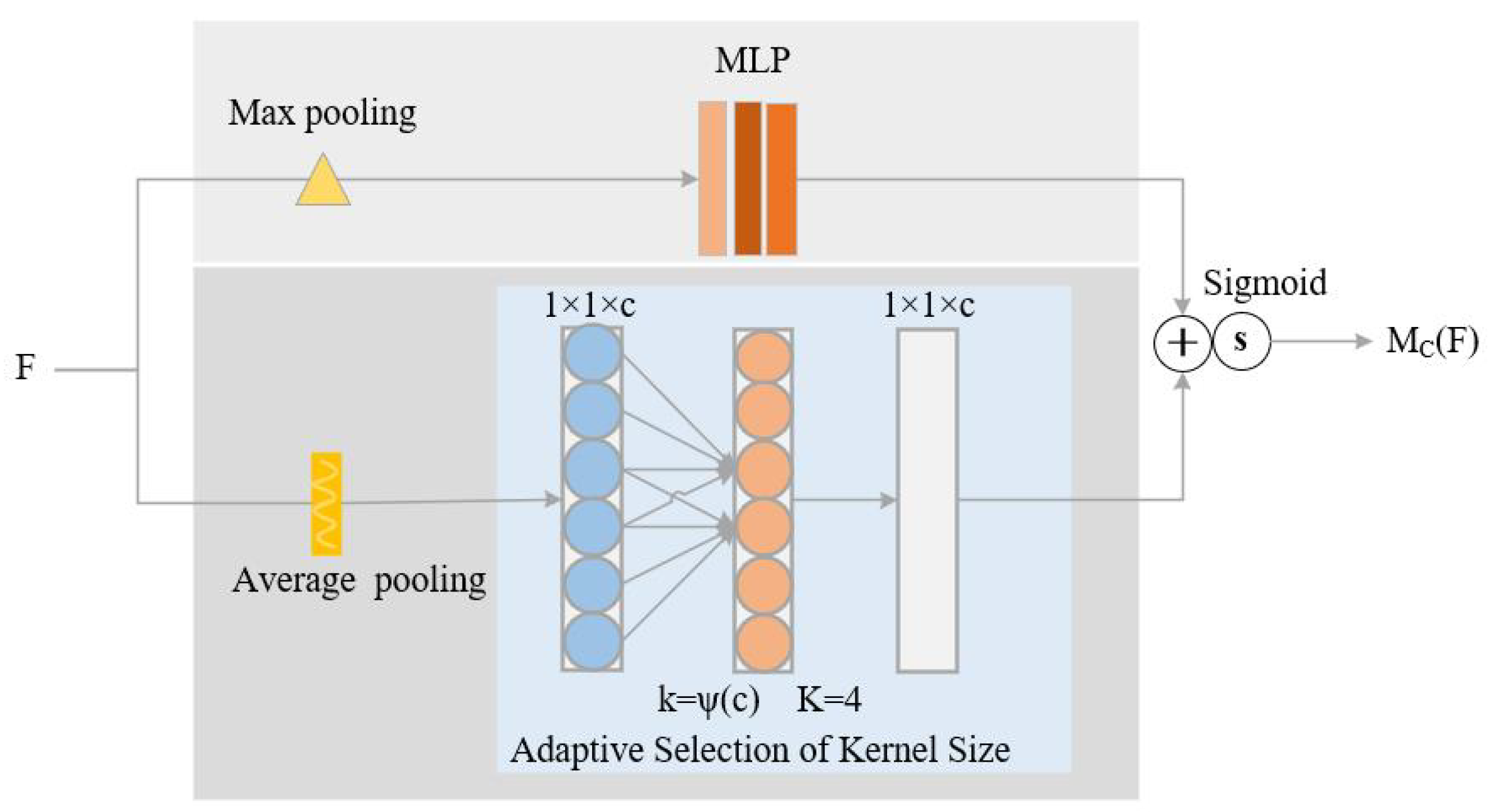
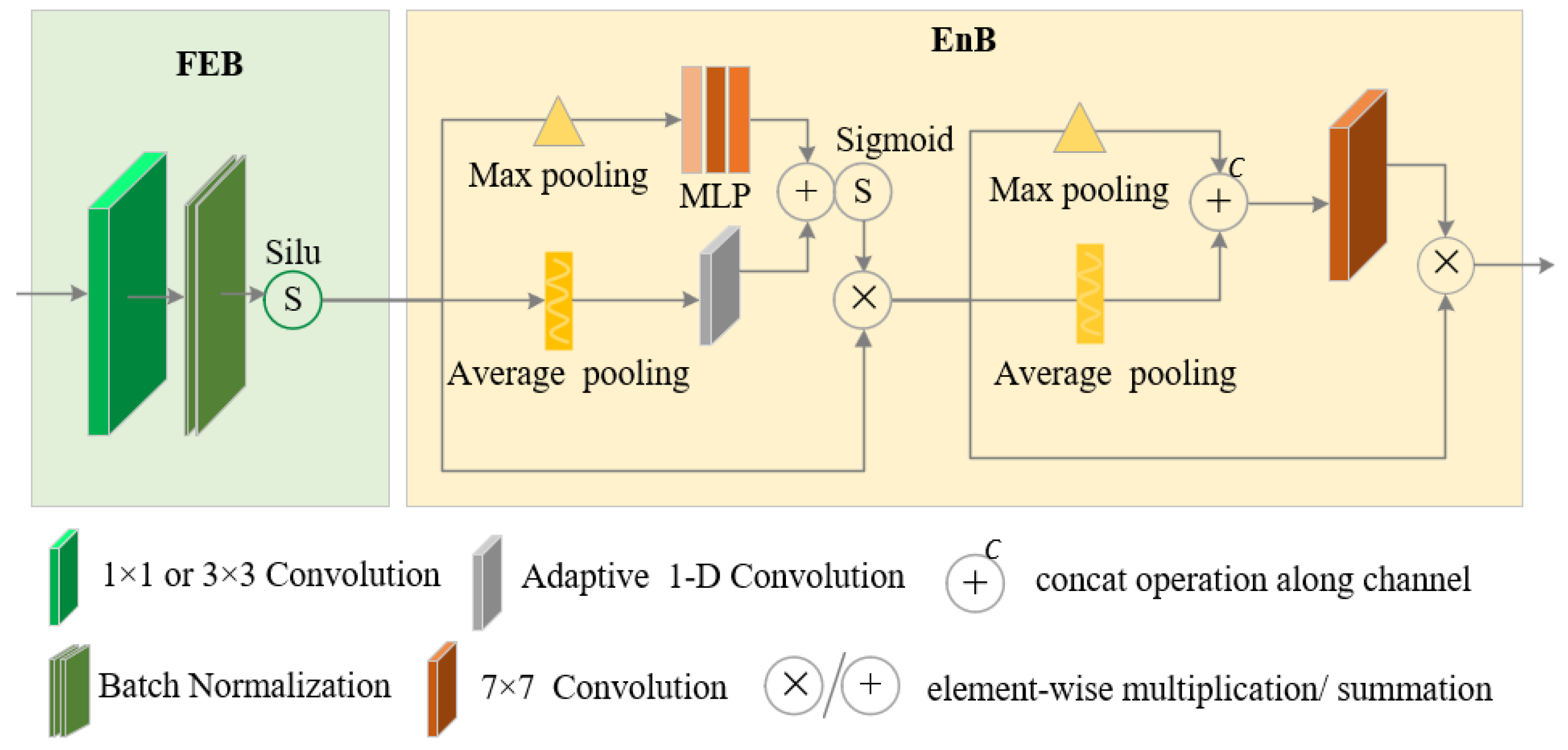
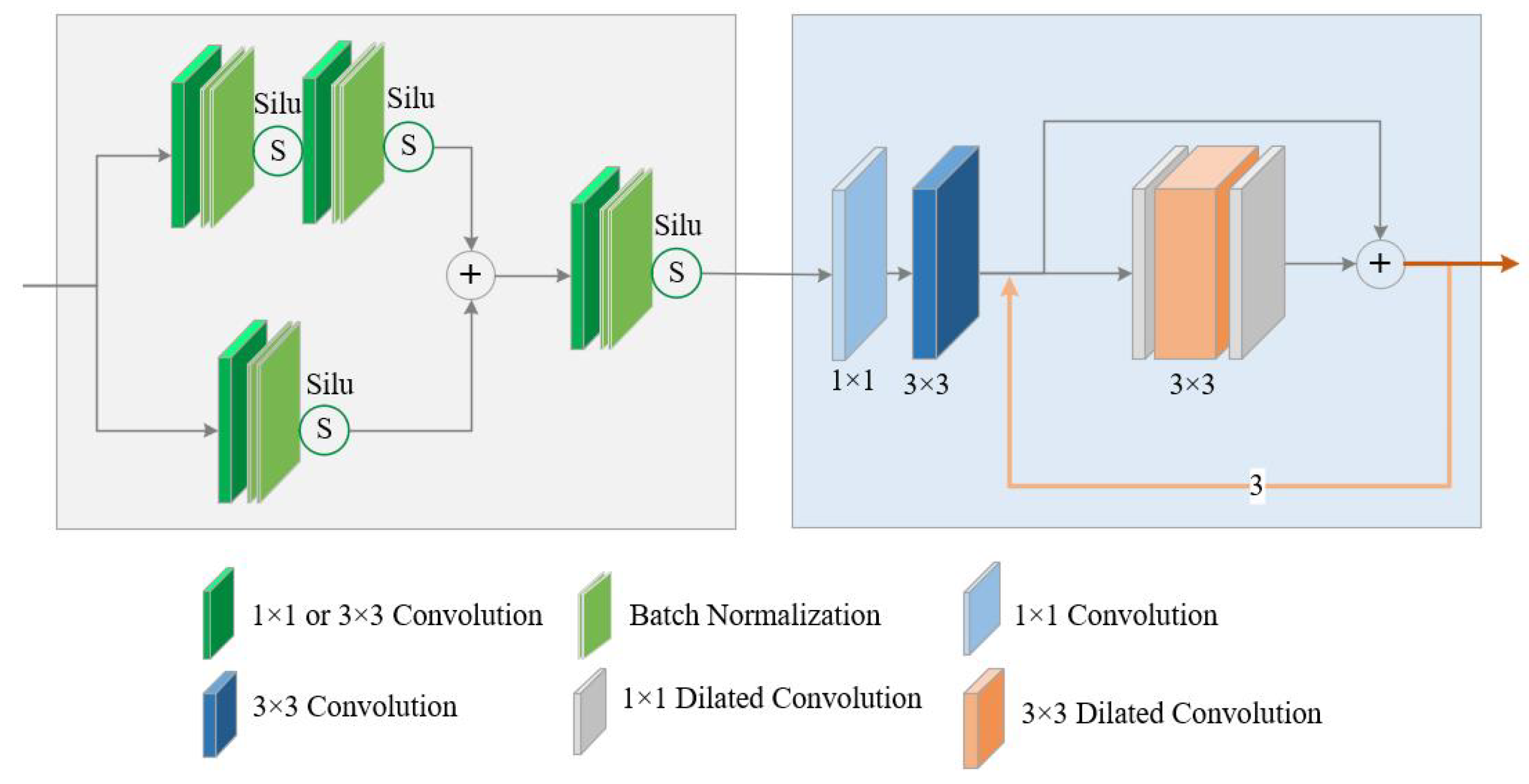
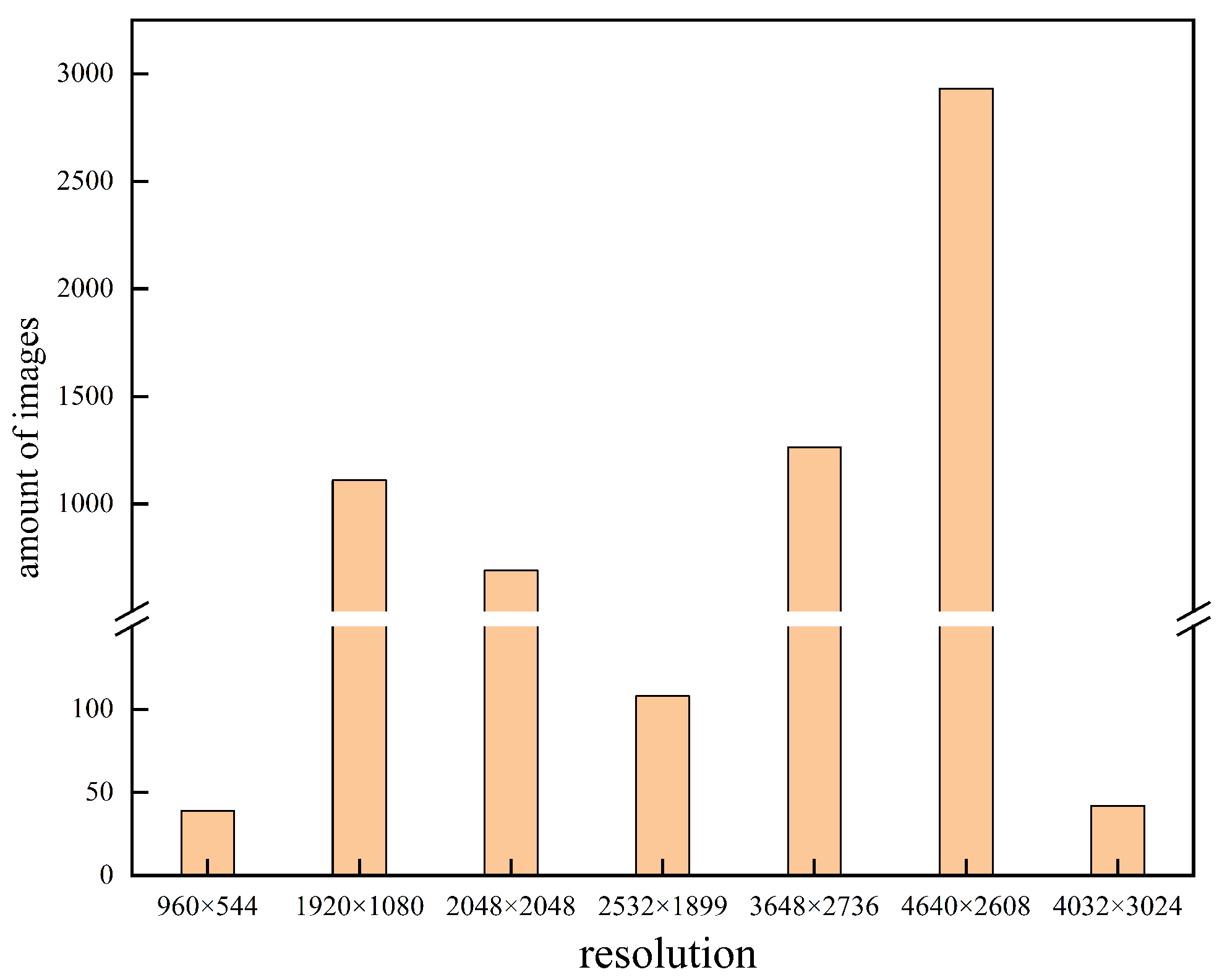



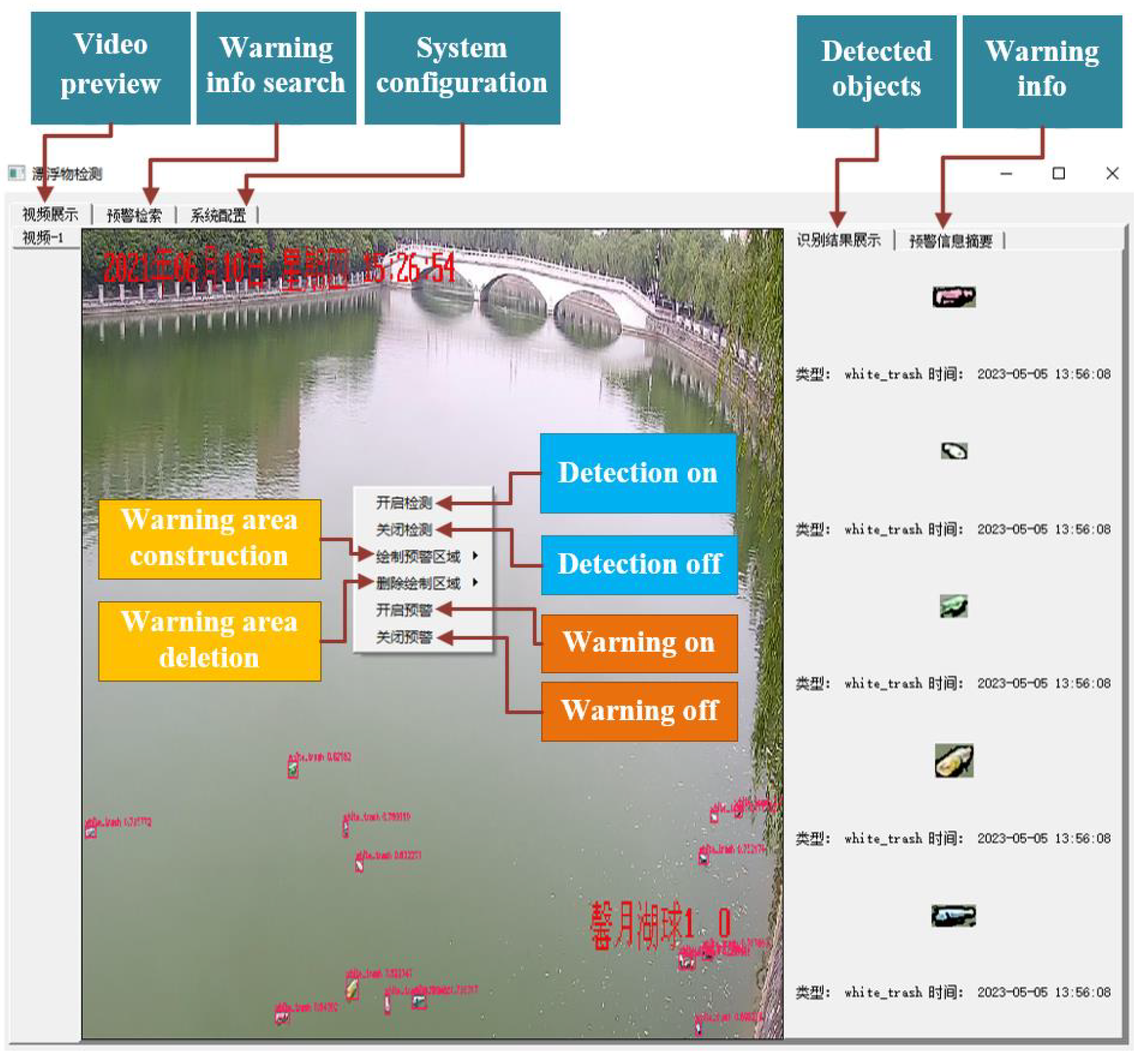
| Feature Map | Receptive Field | Anchor |
|---|---|---|
| 20 × 20 | Large | (105, 42), (114, 88), (209, 159) |
| 40 × 40 | Medium | (25, 29), (48, 25), (52, 50) |
| 80 × 80 | Small | (10, 6), (15, 10), (29, 15) |
| 160 × 160 | Tiny | (3, 2), (4, 5), (7, 4) |
| Models | New Detection Layer | AFECM | FEEM | Prior Boxes with K-Mediods Algorithm | mAP(%)0.5 | Recall | F1-Score |
|---|---|---|---|---|---|---|---|
| Model1 | × | × | × | × | 78.00 | 71.80 | 79.88 |
| Model2 | √ | × | × | × | 78.30 | 76.90 | 80.61 |
| Model3 | √ | √ | × | × | 78.40 | 72.50 | 79.46 |
| Model4 | √ | √ | √ | × | 78.80 | 74.90 | 80.24 |
| Model5 (YOLO-FF) | √ | √ | √ | √ | 80.80 | 79.60 | 82.35 |
| Models | AP | mAP(%)0.5 | Recall | F1-Score | |
|---|---|---|---|---|---|
| Plant_Mixture | White_Trash | ||||
| YOLOv5-FF | 72.90 | 88.70 | 80.80 | 79.60 | 82.35 |
| YOLOv8n | 66.40 | 71.80 | 69.10 | 61.60 | 70.09 |
| YOLOv8s | 67.60 | 72.10 | 69.80 | 62.40 | 72.32 |
| YOLOv7 | 50.70 | 79.50 | 65.10 | 59.70 | 67.48 |
| YOLOX | 60.40 | 80.50 | 70.43 | - | - |
| YOLOv5 | 70.60 | 85.50 | 78.00 | 71.80 | 79.88 |
| YOLOv4 | 42.20 | 66.00 | 54.10 | 64.70 | 45.00 |
| YOLOv3 | 69.00 | 88.90 | 79.00 | 71.40 | 79.63 |
| SSD | 46.96 | 36.28 | 41.62 | 18.99 | 31.46 |
| Faster-RCNN | 60.84 | 38.4 | 49.62 | 54.52 | 60.32 |
| YOLOv5-CB | 65.2 | 86.4 | 75.8 | 70.10 | 78.31 |
| Models | FPS |
|---|---|
| YOLOv5-FF | 78 |
| YOLOv8n | 129 |
| YOLOv8s | 113 |
| YOLOv7 | 26 |
| YOLOX | 36 |
| YOLOv5 | 131 |
| YOLOv4 | 36 |
| YOLOv3 | 53 |
| SSD | 31 |
| Faster-RCNN | 24 |
| YOLOv5-CB | 120 |
Disclaimer/Publisher’s Note: The statements, opinions and data contained in all publications are solely those of the individual author(s) and contributor(s) and not of MDPI and/or the editor(s). MDPI and/or the editor(s) disclaim responsibility for any injury to people or property resulting from any ideas, methods, instructions or products referred to in the content. |
© 2023 by the authors. Licensee MDPI, Basel, Switzerland. This article is an open access article distributed under the terms and conditions of the Creative Commons Attribution (CC BY) license (https://creativecommons.org/licenses/by/4.0/).
Share and Cite
Zhang, X.; Min, C.; Luo, J.; Li, Z. YOLOv5-FF: Detecting Floating Objects on the Surface of Fresh Water Environments. Appl. Sci. 2023, 13, 7367. https://doi.org/10.3390/app13137367
Zhang X, Min C, Luo J, Li Z. YOLOv5-FF: Detecting Floating Objects on the Surface of Fresh Water Environments. Applied Sciences. 2023; 13(13):7367. https://doi.org/10.3390/app13137367
Chicago/Turabian StyleZhang, Xiaohong, Changzhuo Min, Junwei Luo, and Zhiying Li. 2023. "YOLOv5-FF: Detecting Floating Objects on the Surface of Fresh Water Environments" Applied Sciences 13, no. 13: 7367. https://doi.org/10.3390/app13137367
APA StyleZhang, X., Min, C., Luo, J., & Li, Z. (2023). YOLOv5-FF: Detecting Floating Objects on the Surface of Fresh Water Environments. Applied Sciences, 13(13), 7367. https://doi.org/10.3390/app13137367






